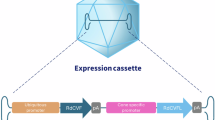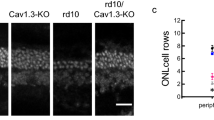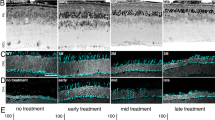Abstract
Retinitis pigmentosa is an untreatable, inherited retinal disease that leads to blindness. The disease initiates with the loss of night vision due to rod photoreceptor degeneration, followed by irreversible, progressive loss of cone photoreceptor1,2,3. Cone loss is responsible for the main visual handicap, as cones are essential for day and high-acuity vision4. Their loss is indirect, as most genes associated with retinitis pigmentosa are not expressed by these cells. We previously showed that factors secreted from rods are essential for cone viability5,6,7,8. Here we identified one such trophic factor by expression cloning and named it rod-derived cone viability factor (RdCVF). RdCVF is a truncated thioredoxin-like protein specifically expressed by photoreceptors. The identification of this protein offers new treatment possibilities for retinitis pigmentosa.
This is a preview of subscription content, access via your institution
Access options
Subscribe to this journal
Receive 12 print issues and online access
$259.00 per year
only $21.58 per issue
Buy this article
- Purchase on SpringerLink
- Instant access to full article PDF
Prices may be subject to local taxes which are calculated during checkout





Similar content being viewed by others
References
Rosenfeld, P.J. et al. A null mutation in the rhodopsin gene causes rod photoreceptor dysfunction and autosomal recessive retinitis pigmentosa. Nat. Genet. 1, 209–213 (1992).
McLaughlin, M.E., Sandberg, M.A., Berson, E.L. & Dryja, T.P. Recessive mutations in the gene encoding the beta-subunit of rod phosphodiesterase in patients with retinitis pigmentosa. Nat. Genet. 4, 130–134 (1993).
Kajiwara, K., Berson, E.L. & Dryja, T.P. Digenic retinitis pigmentosa due to mutations at the unlinked peripherin/RDS and ROM1 loci. Science 264, 1604–1608 (1994).
Dowling, J.E. The retina: an approachable part of the brain. in Retinal Cells and Processing (Harvard University Press, Cambridge, Massachusetts, 1987).
Mohand-Saïd, S. et al. Photoreceptor transplants increase host cone survival in the retinal degeneration (rd) mouse. Ophthalmic Res. 29, 290–297 (1997).
Mohand-Saïd, S., Hicks, D., Léveillard, T., Dreyfus, H. & Sahel, J. Selective transplantation of rods delays cone loss in a retinitis pigmentosa model. Arch. Ophthalmol. 118, 807–811 (2000).
Mohand-Saïd, S. et al. Normal rod photoreceptors increase cone survival in the retinal degeneration (rd) mouse. Proc. Natl. Acad. Sci. USA 95, 8357–8362 (1998).
Fintz, A.C. et al. Partial characterization of retina-derived cone neuroprotection in two culture models of photoreceptor degeneration. Invest. Ophthalmol. Vis. Sci. 44, 818–825 (2003).
Adler, R. & Hatlee, M. Plasticity and differentiation of embryonic retinal cells after terminal mitosis. Science 243, 391–393 (1989).
Fontaine, V., Kinkl, N., Sahel, J., Dreyfus, H. & Hicks, D. Survival of purified rat photoreceptors in vitro is stimulated directly by fibroblast growth factor-2. J. Neurosci. 18, 9662–9672 (1998).
Carter-Dawson, L.D., La Vail, M.M. & Sidman, R.L. Differential effect of the rd mutation on rods and cones in the mouse retina. Invest. Ophthalmol. Vis. Sci. 17, 489–498 (1978).
Zack, D. Neurotrophic rescue of photoreceptors: are Müller cells the mediator of survival? Neuron 26, 285–286 (2000).
Arner, E.S. & Holmgren, A. Physiological functions of thioredoxin and thioredoxin reductase. Eur. J. Biochem. 267, 6102–6109 (2000).
Holmgren, A. Thioredoxin catalyzes the reduction of insulin disulfides by dithiothreitol and dihydrolipoamide. J. Biol. Chem. 254, 9627–9632 (1979).
Wakasugi, N. et al. Adult T-cell leukemia-derived factor/thioredoxin, produced by both human T-lymphotropic virus type I- and Epstein-Barr virus-transformed lymphocytes, acts as an autocrine growth factor and synergizes with interleukin 1 and interleukin 2. Proc. Natl. Acad. Sci. USA 87, 8282–8286 (1990).
Nickel, W. The mystery of nonclassical protein secretion. A current view on cargo proteins and potential export routes. Eur. J. Biochem. 270, 2109–2119 (2003).
Jefferey, C.J. Moonlighting proteins. Trends Biochem. Sci. 24, 8–11 (1999).
Chen, C. & Okayama, H. High-efficiency transformation of mammalian cells by plasmid DNA. Mol. Cell. Biol. 7, 2745–2752 (1987).
Altschul, S.F. et al. Gapped BLAST and PSI-BLAST: a new generation of protein database search programs. Nucleic Acids Res. 25, 3389–3402 (1997).
Cau, E., Gradwohl, G., Fode, C. & Guillemot, F. Mash1 activates a cascade of bHLH regulators in olfactory neuron progenitors. Development 124, 1611–1621 (1997).
Dixon, W.J. & Massey, F.J. Jr. Statistical test for significance. Introduction to Statistical Analysis (McGraw-Hill, New York, 1969).
Acknowledgements
We thank A. Gluck, J. Ravey, D. Thiersé, M. Simonutti, V. Forster, N. Hanotteau, G. Millet-Puel, G. Lucchi, P. Oberlin and G. Tarlet for technical assistance; A. Dolemeyer, C. Grolleau, E. Scherbeck and P.-Y. Boelle for help; P. Chambon for support; and E. Borelli, O. Goureau, V. Heidinger, A. Triller and D. Zack for critical reading of the manuscript. This work was financed by Novartis, Inserm, Ministère de la Recherche, the Association Française contre les Myopathies, the Fédération des Aveugles de France, Retina France, Foundation Fighting Blindness (USA), IPSEN Foundation and the European Community (PRO-AGE-RET program).
Author information
Authors and Affiliations
Corresponding author
Ethics declarations
Competing interests
The authors filed a patent on disease-associated protein on 4 June 2001 (international extension on 4 June 2002), EP 1379657.
Supplementary information
Supplementary Fig. 1
RdCVF sequence. (PDF 82 kb)
Rights and permissions
About this article
Cite this article
Léveillard, T., Mohand-Saïd, S., Lorentz, O. et al. Identification and characterization of rod-derived cone viability factor. Nat Genet 36, 755–759 (2004). https://doi.org/10.1038/ng1386
Received:
Accepted:
Published:
Issue date:
DOI: https://doi.org/10.1038/ng1386
This article is cited by
-
Optimal Control with RdCVFL for Degenerating Photoreceptors
Bulletin of Mathematical Biology (2024)
-
Late gene therapy limits the restoration of retinal function in a mouse model of retinitis pigmentosa
Nature Communications (2023)
-
Mechanism of Cone Degeneration in Retinitis Pigmentosa
Cellular and Molecular Neurobiology (2023)
-
Potential therapeutic strategies for photoreceptor degeneration: the path to restore vision
Journal of Translational Medicine (2022)
-
A mathematical model of GLUT1 modulation in rods and RPE and its differential impact in cell metabolism
Scientific Reports (2022)



